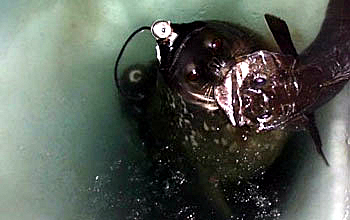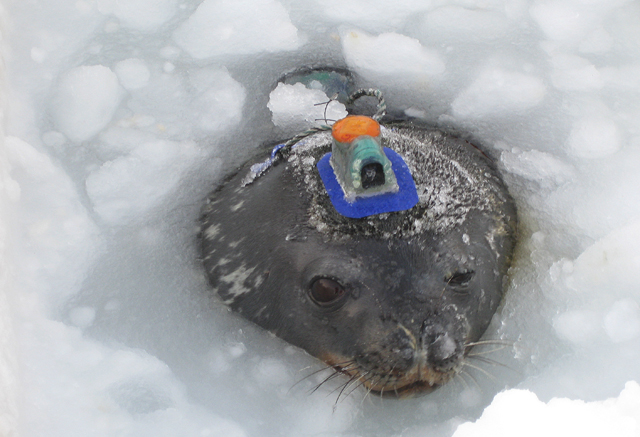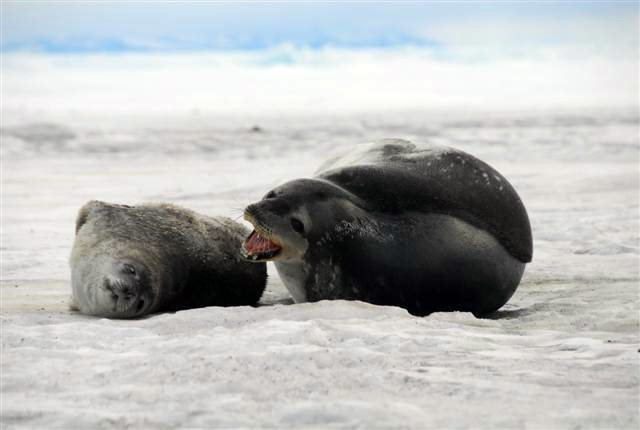Night huntScientists track seal predation behavior through the dark of AntarcticaPosted August 27, 2010
Nearly 30 years ago, Randall Davis The living conditions were fairly primitive — two orange “fish huts” connected by a covered vestibule, with an outhouse on the side. The technology of the day was fairly simple — mechanical time-depth recorders that the scientists placed on the seal’s hind flippers when the animals occasionally hauled themselves onto the ice shelf. They learned much about the animals’ behavior through observation, though hard data were sparse. Much of their time was spent looking after their own survival against wood-splintering-strength winds and temperatures that plunged to minus 50 degrees centigrade. Fast-forward to 2010. Davis and co-principal investigators Lee Fuiman and Terrie Williams “What we’re finding is that the seals will take advantage of what light is available, but hopefully when we analyze all of the data in detail, we’ll find periods that they’re actually hunting during the dark period of the day-night cycle that exists during Winfly,” explained Davis, a professor in the Department of Marine Biology at Texas A&M University in Galveston Operationally, Winfly is the time every August when the U.S. Antarctic Program Scientifically, Winfly is about as close to winter darkness as Davis and his team can get, without actually wintering over. This year, they will arrive about a week earlier than the normal Winfly season, when there is still about 24 hours of darkness each day. “The extra week will buy us some additional periods of darkness. The light level is changing so rapidly, even a week is helpful,” Davis said. The first sunrise is Aug. 19, with sun visible for little more than an hour. By the end of the month, the sun is up for more than six-and-a-half hours. Daylight then gains about 15 minutes a day in September. Noted Fuiman, “We run out of darkness pretty quickly.” Years of researchMuch of the research on Weddell seal behavior began in the 1960s with a physiologist from Scripps Institution of Oceanography 
Photo Credit: Randall Davis
A Weddell seal with a toothfish in its mouth and sporting an earlier model of the video-data recorder.
Kooyman used a simple but effective time-depth recorder made out of a kitchen egg timer and a glass disk coated with fine charcoal dust to chart the seals’ dives. Changes in hydrostatic pressure as the seals changed depth forced a stylus to make etchings on the glass. The timer ticked off the minutes. Kooyman discovered that the seals could remain submerged for more than an hour, diving down 500 meters in depth. Kooyman continued his work into the 1980s, when researchers like Davis and Williams took up new problems that required new technologies to address. “Because we couldn’t observe the animal at depth, it left a lot of questions about what it was doing while diving unanswered,” Davis said. That motivated him to develop an underwater video data recorder that could be mounted on the seals to record their hunting behavior along three-dimensional maps, swimming performance and environment. A professor with the Marine Science Institute at the University of Texas at Austin “Since the seals’ behavior is done while hold their breath, the physiology is a pretty important part of understanding their ecology. Together the three of us make a really strong team in understanding what these seals are doing,” Fuiman said. It worked. The technology not only offered insights into seal behavior, but also provided valuable data on two of its prey — the Antarctic silverfish and the Antarctic toothfish. They eventually published a paper on their findings in Marine Biology, along with numerous other papers on the seals. [See previous story in The Antarctic Sun, Dec. 22, 2002 “I don’t think anybody else has data like this because it is so difficult to collect data from the point of view of the predators. I think there is a goldmine there, and I suspect that there will be something publishable about seal prey in the future,” Fuiman said.1 2 Next |



For USAP Participants |
For The Public |
For Researchers and EducatorsContact UsU.S. National Science FoundationOffice of Polar Programs Geosciences Directorate 2415 Eisenhower Avenue, Suite W7100 Alexandria, VA 22314 Sign up for the NSF Office of Polar Programs newsletter and events. Feedback Form |



